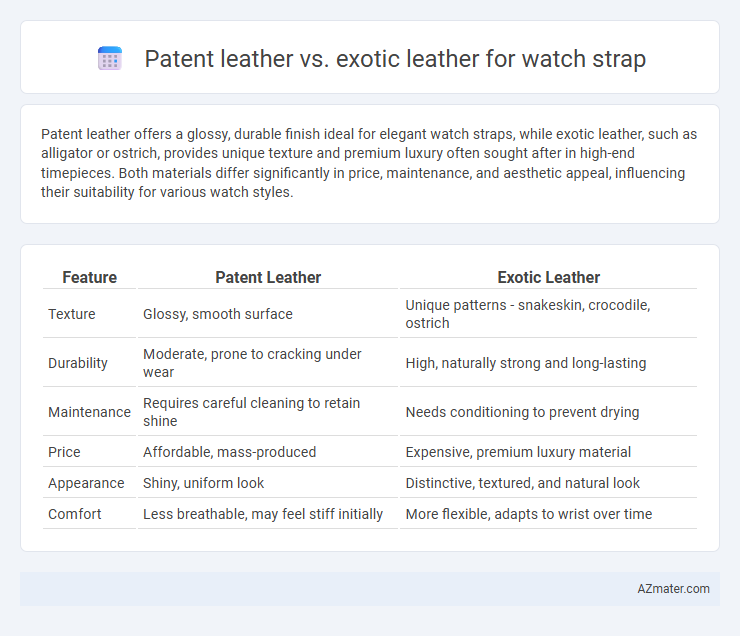Patent leather offers a glossy, durable finish ideal for elegant watch straps, while exotic leather, such as alligator or ostrich, provides unique texture and premium luxury often sought after in high-end timepieces. Both materials differ significantly in price, maintenance, and aesthetic appeal, influencing their suitability for various watch styles.
Table of Comparison
| Feature | Patent Leather | Exotic Leather |
|---|---|---|
| Texture | Glossy, smooth surface | Unique patterns - snakeskin, crocodile, ostrich |
| Durability | Moderate, prone to cracking under wear | High, naturally strong and long-lasting |
| Maintenance | Requires careful cleaning to retain shine | Needs conditioning to prevent drying |
| Price | Affordable, mass-produced | Expensive, premium luxury material |
| Appearance | Shiny, uniform look | Distinctive, textured, and natural look |
| Comfort | Less breathable, may feel stiff initially | More flexible, adapts to wrist over time |
Introduction to Leather Watch Straps
Leather watch straps, including patent leather and exotic leather, offer distinct aesthetic and functional qualities for watch enthusiasts. Patent leather is characterized by its glossy, smooth finish achieved through a lacquer coating, providing a sleek and formal appearance. Exotic leather, derived from materials such as alligator, ostrich, or python, showcases unique textures and patterns, often valued for its exclusivity and luxury appeal in high-end watch straps.
What is Patent Leather?
Patent leather is a type of leather known for its glossy, shiny surface achieved through a coating process using lacquer or varnish that enhances its durability and water resistance. It is typically made from cowhide but treated to have a mirror-like finish, making it a stylish option for watch straps that require a polished look. Compared to exotic leather, patent leather offers a more uniform appearance and easier maintenance, while exotic leathers like alligator or ostrich provide unique textures and natural patterns valued for luxury and exclusivity.
What is Exotic Leather?
Exotic leather for watch straps refers to materials sourced from unique and rare animals such as alligator, crocodile, ostrich, or python, prized for their distinctive textures and durability. Unlike patent leather, which is characterized by its glossy, lacquered finish created through coating processes on cowhide, exotic leather showcases natural patterns and scales that provide a luxurious and authentic aesthetic. The premium quality and rarity of exotic leather significantly enhance the exclusivity and craftsmanship of high-end watch straps.
Aesthetic Differences: Patent vs Exotic Leather
Patent leather watch straps feature a glossy, highly reflective finish that offers a sleek, polished appearance perfect for formal occasions, whereas exotic leather straps, such as alligator or ostrich, display rich, natural textures with distinctive scales or patterns that convey luxury and uniqueness. The smooth, uniform surface of patent leather contrasts sharply with the uneven, tactile grain of exotic leather, providing markedly different visual and tactile experiences. Selecting between them depends on whether a wearer prefers the modern shine of patent leather or the organic sophistication of exotic leather's natural patterns.
Durability and Longevity Comparison
Patent leather watch straps offer a glossy, smooth finish but are more prone to cracking and scuffing over time due to their coated surface, impacting durability. Exotic leather straps, such as alligator or ostrich, provide superior longevity with natural toughness and resistance to wear, making them a preferred choice for long-lasting luxury watch bands. The inherent fibers in exotic leathers maintain structural integrity better under daily use, extending the strap's lifespan significantly compared to patent leather.
Comfort and Wearability
Patent leather watch straps provide a sleek, glossy finish but tend to be less breathable and flexible, potentially causing discomfort during prolonged wear. Exotic leathers such as alligator, ostrich, or lizard offer enhanced durability and natural texture, contributing to superior comfort and better adaptability to wrist contours. The porous nature of exotic leathers allows for improved ventilation, reducing sweat buildup and enhancing overall wearability compared to patent leather.
Price and Value Assessment
Patent leather watch straps generally offer an affordable price point with a glossy finish that appeals to fashion-conscious buyers seeking cost-effective luxury. Exotic leather straps, such as alligator or ostrich, command significantly higher prices due to their rarity, durability, and unique textures, often enhancing the watch's overall resale value. The value assessment hinges on whether the buyer prioritizes long-lasting exclusivity and prestige, which exotic leathers provide, or budget-friendly style with patent leather options.
Maintenance and Care Requirements
Patent leather watch straps require regular wiping with a damp cloth to maintain their glossy finish and avoid cracking, while avoiding exposure to extreme heat or moisture that can cause discoloration. Exotic leather straps, such as alligator or ostrich, demand more specialized care including conditioning with leather-specific products and protection from prolonged sunlight to prevent drying and fading. Both materials benefit from gentle cleaning routines, but exotic leathers often need professional maintenance to preserve their unique texture and durability.
Ethical and Environmental Considerations
Patent leather watch straps undergo a chemical-intensive finishing process that raises environmental concerns due to the use of toxic solvents and heavy metals. Exotic leather, sourced from species like alligator or python, often involves ethical issues related to wildlife conservation and the sustainability of animal populations. Alternatives such as plant-based or recycled materials present more eco-friendly and cruelty-free options for watch strap production.
Which Leather is Best for Your Watch Strap?
Patent leather offers a glossy, polished finish that enhances formal watch straps with durability and water resistance, making it ideal for elegant occasions. Exotic leather, such as alligator or python, provides a unique texture and superior flexibility, appealing to luxury enthusiasts seeking a statement piece. Choose patent leather for classic sophistication and ease of maintenance, while exotic leather suits those prioritizing exclusivity and intricate design.

Infographic: Patent leather vs Exotic leather for Watch strap
 azmater.com
azmater.com